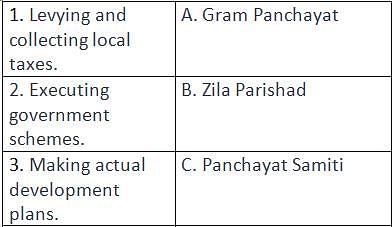Class 6 Exam > Class 6 Tests > Test: Livelihoods-Rural and Urban - 1 - Class 6 MCQ
Test: Livelihoods-Rural and Urban - 1 - Class 6 MCQ
Test Description
10 Questions MCQ Test - Test: Livelihoods-Rural and Urban - 1
Test: Livelihoods-Rural and Urban - 1 for Class 6 2024 is part of Class 6 preparation. The Test: Livelihoods-Rural and Urban - 1 questions and answers have been prepared
according to the Class 6 exam syllabus.The Test: Livelihoods-Rural and Urban - 1 MCQs are made for Class 6 2024 Exam.
Find important definitions, questions, notes, meanings, examples, exercises, MCQs and online tests for Test: Livelihoods-Rural and Urban - 1 below.
Solutions of Test: Livelihoods-Rural and Urban - 1 questions in English are available as part of our course for Class 6 & Test: Livelihoods-Rural and Urban - 1 solutions in
Hindi for Class 6 course.
Download more important topics, notes, lectures and mock test series for Class 6 Exam by signing up for free. Attempt Test: Livelihoods-Rural and Urban - 1 | 10 questions in 10 minutes | Mock test for Class 6 preparation | Free important questions MCQ to study for Class 6 Exam | Download free PDF with solutions
Test: Livelihoods-Rural and Urban - 1 - Question 1
The Panchayati Raj system functions at two levels: Gram Panchayat and Panchayat Samiti.
Detailed Solution for Test: Livelihoods-Rural and Urban - 1 - Question 1
Test: Livelihoods-Rural and Urban - 1 - Question 2
Who is the head of the Zila Parishad, the highest level of the Panchayati Raj system?
Detailed Solution for Test: Livelihoods-Rural and Urban - 1 - Question 2
| 1 Crore+ students have signed up on EduRev. Have you? Download the App |
Test: Livelihoods-Rural and Urban - 1 - Question 3
The Gram Sabha is a meeting where all ____________ who live in the area are covered by a Panchayat.
Detailed Solution for Test: Livelihoods-Rural and Urban - 1 - Question 3
Test: Livelihoods-Rural and Urban - 1 - Question 5
The Sarpanch of the Gram Sabha is elected by the members of the Gram Panchayat.
Detailed Solution for Test: Livelihoods-Rural and Urban - 1 - Question 5
Test: Livelihoods-Rural and Urban - 1 - Question 6
The Gram Panchayat's governance over the villagers lasts for ____________ years.
Detailed Solution for Test: Livelihoods-Rural and Urban - 1 - Question 6
Test: Livelihoods-Rural and Urban - 1 - Question 7
Who appoints the secretary of the Gram Panchayat?
Detailed Solution for Test: Livelihoods-Rural and Urban - 1 - Question 7
Test: Livelihoods-Rural and Urban - 1 - Question 8
The Gram Sabha prevents the Panchayat from favoring certain individuals in the village.
Detailed Solution for Test: Livelihoods-Rural and Urban - 1 - Question 8
Test: Livelihoods-Rural and Urban - 1 - Question 10
What is the primary objective of the provision allowing states to have their own laws regarding Gram Panchayats?
Detailed Solution for Test: Livelihoods-Rural and Urban - 1 - Question 10
Information about Test: Livelihoods-Rural and Urban - 1 Page
In this test you can find the Exam questions for Test: Livelihoods-Rural and Urban - 1 solved & explained in the simplest way possible.
Besides giving Questions and answers for Test: Livelihoods-Rural and Urban - 1, EduRev gives you an ample number of Online tests for practice
Download as PDF



















